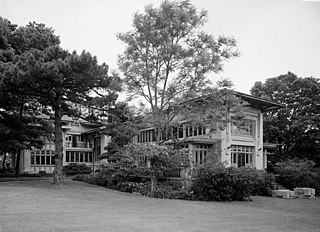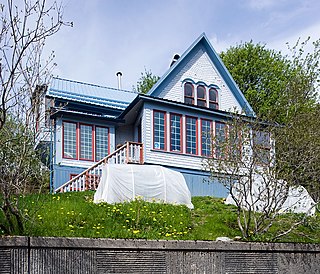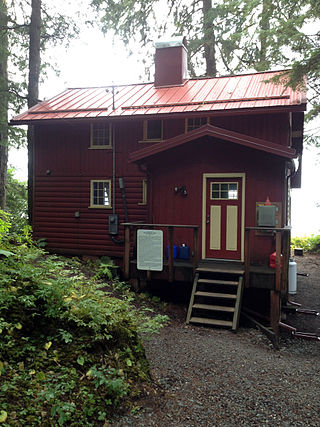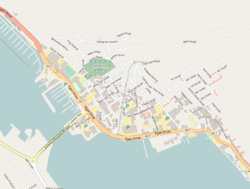
The Mathias Ham House is a 19th-century house in Dubuque, Iowa that is on the National Register of Historic Places. It is located at the intersection of Shiras and Lincoln Avenues, near the entrances to Eagle Point Park and Riverview Park.

U.S. Route 66 is a former east–west United States Numbered Highway, running from Santa Monica, California to Chicago, Illinois. In Missouri, the highway ran from downtown St. Louis at the Mississippi River to the Kansas state line west of Joplin. The highway was originally Route 14 from St. Louis to Joplin and Route 1F from Joplin to Kansas. It underwent two major realignments and several lesser realignments in the cities of St. Louis, Springfield, and Joplin. Current highways covering several miles of the former highway include Route 100, Route 366, Route 266, Route 96, and Route 66. Interstate 44 (I-44) approximates much of US 66 between St. Louis and Springfield.

Pendarvis is a historic site located in Mineral Point, Iowa County, Wisconsin, United States. The site, which is listed on the National Register of Historic Places, is made up of several 19th century cabins built by Cornish immigrants who came to Mineral Point to mine lead. Today the site is owned by the Wisconsin Historical Society and serves as a museum of Wisconsin's early lead mining history. Programs at the site also interpret the groundbreaking preservation work by Robert Neal and Edgar Hellum, begun during the Great Depression.

The Treadwell gold mine was on the south side of Douglas Island, .5-mile (0.80 km) east of downtown Douglas and southeast of downtown Juneau, owned and operated by John Treadwell. Composed of four sub-sites, Treadwell was in its time the largest hard rock gold mine in the world, employing over 2,000 people. Between 1881 and 1922, over 3 million troy ounces of gold were extracted. Not much remains today except for a few crumbling buildings and a "glory hole". Although John Treadwell had twelve years of experience in both placer and lode mines, he was a carpenter and builder by trade who had come to Alaska prior to the Klondike Gold Rush.

The Anheuser-Busch Beer Depot is located at 1207-1215 Jones Street in downtown Omaha, Nebraska. Omaha architect Henry Voss designed the complex for the Anheuser-Busch Brewing Association of St. Louis, Missouri in 1887.

Southwest Garden is a neighborhood of St. Louis, Missouri, located south of The Hill and Forest Park Southeast, west of the Missouri Botanical Garden and Tower Grove Park, east of Lindenwood Park and Clifton Heights, and north of North Hampton.

Anheuser-Busch Brewery is a brewery complex in St. Louis, Missouri. It was opened in 1852 by German immigrant Adolphus Busch. It a National Historic Landmark District. The Lyon Schoolhouse Museum is on the grounds at the Anheuser-Busch Brewery. It is considered to be one of oldest school buildings in St Louis. It served as the head offices of the brewery after 1907. The museum contains rare mementos gathered from the founding of the company to current day, including pictures of the brewery and its expansion over the years. The 142 acres (57 ha) property includes 189 buildings. Some of the most striking are red brick Romanesque architecture with crenelated towers and elaborate ornamentation.

Felice Pedroni, known best to Americans by his Hispanicized alias Felix Pedro, was an Italian immigrant whose discovery of gold in Interior Alaska marked the beginning of the 1902 Fairbanks Gold Rush.

The Bernard Corrigan House is a historic residence at 1200 West 55th Street in the Country Club District, Kansas City, Missouri. The building is an important regional example of the Prairie Style, and it was one of the earliest residential structures in Kansas City to make extensive use of reinforced concrete. It was added to the National Register of Historic Places in 1978.

The St. Nicholas Russian Orthodox Church in Juneau, Alaska, United States, was built in 1893 and was listed on the National Register of Historic Places in 1973. Now it is under Diocese of Alaska of the Orthodox Church in America.
Starr Hill is a populated place in Juneau, Alaska, United States. It is named for Frank Starr (1849-1898), a soldier from Maine who arrived shortly after the discovery of the Juneau gold fields in 1880, staked some claims but mainly found work in construction. Starr also staked land on the hill near the road leading to the Silver Bow Basin gold fields. The Hill saw significant development beginning in 1913 when Conrad Fries built six miners’ cabins on the 500 block of Kennedy Street, buildings which are now listed on the National Register of Historic Places. A few years later Juneau businessman Bernard (B.M.) Behrends built five smaller cabins on the 400 block of Kennedy. Starr Hill now includes several dozen private homes which overlook upper Juneau and the Alaska State Capitol, and a trailhead to the Mount Roberts Trail.
John Treadwell (1842–1927) was a Canadian gold miner. He was born in St. Andrews, New Brunswick, Canada. He owned and operated the Treadwell gold mine through the Treadwell Mining Company. He was responsible for initiating low-grade gold mining in Alaska adopting most advanced operations on a big scale, which boosted the economy of the wilderness areas. His four mines formed the largest complex in the world at that time. Treadwell's mine complex "put Juneau on the map".

The Alaska Steam Laundry is a historic commercial building at 174 South Franklin Street in Juneau, Alaska. It is a Late Victorian wood-frame structure, with a prominent turret that has a conical roof. Built in 1901, it is a well-preserved element of the transition of Juneau from a mining camp to a more cosmopolitan city. It was built by E. R. Jaeger, who envisioned the laundry as a profitable business serving single miners working the nearby gold mines. The laundry facilities were housed on the ground floor, with residences and office space above. The laundry operated here until 1929, when it was moved to new premises in the city, and this building was converted to other commercial uses.

The J. M. Davis House is a historic house at 202 6th Street in Juneau, Alaska. This two-story wood-frame house was built in 1892, when Juneau was little more than a gold mining camp, and remains one of its most elegant homes of the period, as well as one of its oldest buildings. The builder, J. M. Davis, was a miner whose wife was a wealthy English artist. Their son, Trevor Davis, was a noted Alaskan landscape photographer; the house has also served as the official residence of the local US Coast Guard Admiral.

The Ernest Gruening Cabin is a historic rural cabin in Juneau, Alaska, United States, and the centerpiece of Ernest Gruening State Historical Park. It is a 1+1⁄2-story wood-frame structure located 26 miles (42 km) north of the city on the Glacier Highway. It is the only building associated with the life of Ernest Gruening, governor of the Alaska Territory 1939–53, other than the Alaska Governor's Mansion. The cabin was built on land Gruening leased from the United States Forest Service, and was built by local laborers including Gruening's son Hunt. The cabin measures 24 feet (7.3 m) by 28 feet (8.5 m), with a gable roof and a large fieldstone chimney. Its exterior is finished in shiplap siding milled to resemble unfinished logs. The interior consists of a single large chamber, with a circular stairway leading to a sleeping loft above. The kitchen area is set apart from the rest of the space by different flooring, an alteration by Gruening's grandson. The property is now a state historic site.

The Jualpa Mining Camp, also known as the Last Chance Basin Camp, is a former gold mining camp, just outside the city of Juneau, Alaska. Its main building is now operated as the Last Chance Mining Museum by the Gastineau Historical Society. The camp was located on the southern banks of Gold Creek, about 1 mile (1.6 km) north of Juneau, near what is now the end of Basin Road. The camp was the site of one of the largest gold finds in the Juneau mining district. It was established between 1910 and 1913 by the Alaska-Juneau Gold Mining Company and operated until 1944, producing more than $80 million worth of gold. The largest surviving structure of the camp is its air compressor building, which was 84 feet (26 m) long, and still houses the compressor used by the company. Also surviving are a variety of railroad-related resources, which the company used to bring or to its mill on the Gastineau channel, an electrical transformer house, powder magazine, and cable hoist.

The Juneau Downtown Historic District encompasses the historic commercial heart of the city of Juneau, Alaska. It extends along South Franklin Street, from the cruise terminal in the south to Second Street in the north, and westward along Second and Front Streets to Main Street. This area was the center of Juneau's economic activity from its founding in 1880 as a gold mining camp, through its growth into an urbanized area in the early 20th century, including its eventual designation as the territorial capital in 1906. In the early days of the gold mining camp business was centered in the area bounded by Front, Main and South Franklin, with maritime activities in particular eventually extending further south along the shore of the Gastineau Channel by making land using mine tailings. The early buildings have relatively utilitarian architecture, while those of the early 20th century are somewhat more ornate, with Late Victorian details. Notable buildings from this period include the Alaska Steam Laundry and the Valentine Building.

The MacKinnon Apartments are a historic apartment building at 236 Third Street in Juneau, Alaska. The building is a three-story wood-frame structure, finished in stucco; it has corner quoining and a dentillated cornice. When originally built in 1925, it was 80 feet (24 m) long and housed six single-bedroom and 12 studio apartments. In 1959 20 feet (6.1 m) was added; the extension houses five more studio units. The building is representative of Juneau's boom years in the 1920s which was the peak of the Gold Rush.




















